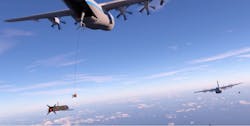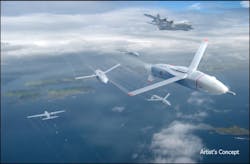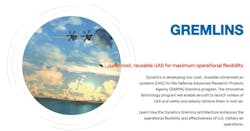Dynetics to advance, demonstrate UAS aerial launch and recovery in Phase 3 of DARPA Gremlins program
HUNTSVILLE, Ala. Defense Advanced Research Projects Agency (DARPA) officials continue to invest in the advancement of technologies to enable the aerial launch and recovery of quantities of low-cost, reusable unmanned aerial systems (UAS). Officials in DARPA’s Tactical Technology Office (TTO) have advanced the Gremlin program to phase 3, issuing a a 21-month, $38.6 million contract award to Dynetics Inc. in Huntsville, Alabama, and its team of industry partners.
The Gremlins program is designed to accelerate the ability, of the U.S. Air Force and perhaps other organizations, to perform aerial launch and recovery of volley quantities of UAS. This capability, once demonstrated and matured, enables a significant expansion of distributed architectures for airborne operations, officials say. The entire program will last 43 months and total $64 million.
The Dynetics solution involves deploying a towed, stabilized capture device below and away from the Lockheed Martin C-130 Hercules four-engine, turboprop military transport aircraft. The air vehicle docks with the device similar to an airborne refueling operation. Once docked and powered off, the air vehicle is raised to the C-130, where it is mechanically secured and stowed. The key technologies can be adapted to enable under-wing recovery and bay recovery by other cargo aircraft.
"Dynetics is very pleased for our Gremlins offering to be selected for the Phase 3 demonstration phase. This contract award is a natural progression of our expansion into providing the Government innovative solutions to solve challenging problems, often under highly accelerated schedules. While we offer prime contractor-like capabilities in several areas, the nature of our company structure and philosophy is well-suited for programs such as Gremlins where innovation, agility and affordability are necessary for success," says Mark Miller, Dynetics vice president for missile and aviation systems.
The Gremlins system is designed to bring benefits to contested environments and low-intensity, routine operations. The ability for a single, manned aircraft to stand off from danger yet manage multiple air vehicles equipped with sensors and other payloads lends itself well to enhanced support of tactical strike, reconnaissance/surveillance, and close air support missions, officials say.
“The unmanned air vehicles utilized in these future operations will carry a variety of different sensors and other payloads, working together to manage and conduct complex, highly-adaptive operations in contested environments," says Tim Keeter, Dynetics deputy program manager and chief engineer. "When they complete their mission, they return to airborne manned platforms to be recovered to a forward operating base where they can be quickly refurbished and put back into the fight. The potential to overwhelm an adversary continuously with multiple volleys is tremendous."
For the Gremlins program, Dynetics assembled a team of industry partners to bring the experience, key technologies, and capabilities needed to develop and demonstrate the Gremlins system.
Kratos Unmanned Aerial Systems is leading the fabrication, assembly, integration, and test of each Gremlins air vehicle.
The Sierra Nevada Corporation (SNC) - Salt Lake City group provides the precision navigation system essential to rendezvous and dock the air vehicle with the C-130.
Key subsystems are provided by a number of companies.
- Williams International will provide the turbofan engine.
- Moog will deliver the control actuation systems.
- Airborne Systems will produce the parachute recovery system.
- Systima will prepare the C-130 pylon and launch controller hardware.
- Applied Systems Engineering, Inc. will deliver the flight computer.
- SNC/Kutta will produce the multi-vehicle control services.
- International Air Response will provide C-130 aircraft and flight test support.
Dynetics and three other companies were awarded a Phase 1 contract in 2016 to conduct preliminary studies to develop an operational system concept with an air recovery capability and to formulate a program plan to demonstrate the Gremlins system. After a down select to two companies in 2017, Dynetics completed the system design under a Phase 2 contract.
For the Phase 3 demonstration, the potential to transition to operational use will be demonstrated through a series of ground and flight tests starting in 2018 and culminating in the airborne launch and safe recovery of multiple unmanned aerial vehicles onto a C-130 aircraft in late 2019.
The Phase 3 award follows several recent prime contractor wins for Dynetics in the military hardware area, including the rapid development and fielding of the precision guided munition, GBU-69/B Small Glide Munition for the U.S. Special Operations Command. The company is also competing for a DARPA contract award for the Mobile Force Protection program.




